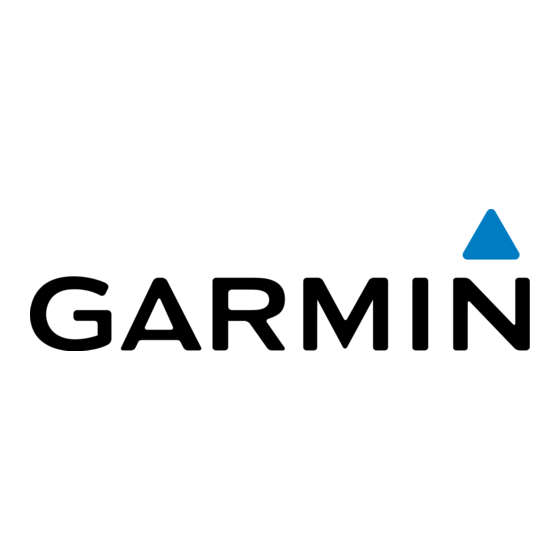Garmin echoMAP CHIRP 70 series Руководство пользователя - Страница 24
Просмотреть онлайн или скачать pdf Руководство пользователя для Морская система GPS Garmin echoMAP CHIRP 70 series. Garmin echoMAP CHIRP 70 series 34 страницы. Fishfinder-chartplotter combo
Также для Garmin echoMAP CHIRP 70 series: Руководство по установке (6 страниц)

• If available, to view information for the day after the date
shown, select Next Day.
• If available, to view information for the day before the date
shown, select Previous Day.
Viewing Information for a Different Tide or Current
Station
1
Select Navigation Info > Tides & Currents.
2
Select Tides or Currents.
3
Select Nearby Stations.
4
Select a station.
Digital Selective Calling
Chartplotter and NMEA
Functionality
When your chartplotter is connected to a NMEA 0183 VHF
radio, these features are enabled.
• The chartplotter can transfer your GPS position to your radio.
If your radio is capable, GPS position information is
transmitted with DSC calls.
• The chartplotter can receive digital selective calling (DSC)
distress and position information from the radio.
• The chartplotter can track the positions of vessels sending
position reports.
Turning On DSC
Select Settings > Other Vessels > DSC.
DSC List
The DSC list is a log of the most recent DSC calls and other
DSC contacts you have entered. The DSC list can contain up to
100 entries. The DSC list shows the most recent call from a
boat. If a second call is received from the same boat, it replaces
the first call in the call list.
Viewing the DSC List
Before you can view the DSC list, the chartplotter must be
connected to a VHF radio that supports DSC.
Select Navigation Info > Other Vessels > DSC List.
Adding a DSC Contact
You can add a vessel to your DSC list. You can make calls to a
DSC contact from the chartplotter.
1
Select Navigation Info > Other Vessels > DSC List > Add
Contact.
2
Enter the Maritime Mobile Service Identity (MMSI) of the
vessel.
3
Enter the name of the vessel.
Incoming Distress Calls
If your compatible chartplotter and VHF radio are connected
using NMEA 0183, your chartplotter alerts you when your VHF
radio receives a DSC distress call. If position information was
sent with the distress call, that information is also available and
recorded with the call.
designates a distress call in the DSC list and marks the
position of the vessel on the Navigation chart at the time of the
DSC distress call.
Navigating to a Vessel in Distress
designates a distress call in the DSC list and marks the
position of a vessel on the Navigation chart at the time of the
DSC distress call.
1
Select Navigation Info > Other Vessels > DSC List.
20
0183 VHF Radio
®
2
Select a position-report call.
3
Select Navigate To.
4
Select Go To or Route To.
Position Tracking
When you connect the chartplotter to a VHF radio using NMEA
0183, you can track vessels that send position reports.
This feature is also available with NMEA 2000, when the vessel
sends the correct PGN data (PGN 129808; DSC Call
Information).
Every position report call received is logged in the DSC list
(DSC List, page
20).
Viewing a Position Report
1
Select Navigation Info > Other Vessels > DSC List.
2
Select a position-report call.
3
Select an option:
• To switch to position report details, select .
• To switch to a Navigation chart marking the location,
select .
• To switch to a Navigation chart marking the location,
select Next Page.
• To view the position report details, select Previous Page.
Navigating to a Tracked Vessel
1
Select Navigation Info > Other Vessels > DSC List.
2
Select a position-report call.
3
Select Navigate To.
4
Select Go To or Route To.
Creating a Waypoint at the Position of a Tracked
Vessel
1
Select Navigation Info > Other Vessels > DSC List.
2
Select a position-report call.
3
Select New Waypoint.
Editing Information in a Position Report
1
Select Navigation Info > Other Vessels > DSC List.
2
Select a position-report call.
3
Select Edit.
• To enter the name of the vessel, select Name.
• To select a new symbol, select Symbol, if available.
• To enter a comment, select Comment.
• To show a trail line for the vessel if your radio is tracking
the position of the vessel, select Trail.
• To select a color for the trail line, select Trail Line.
Deleting a Position-Report Call
1
Select Navigation Info > Other Vessels > DSC List.
2
Select a position-report call.
3
Select Edit > Clear Report.
Viewing Vessel Trails on the Chart
You can view trails for all tracked vessels on some chart views.
By default, a black line indicates the path of the vessel, a black
dot indicates each previously reported position of a tracked
vessel, and a blue flag indicates the last reported position of the
vessel.
1
From a chart or 3D chart view, select MENU > Other
Vessels > DSC Trails.
2
Select the number of hours to show tracked vessels on the
chart.
For example, if you select 4 Hours, all trail points that are
less than four hours old appear for all tracked vessels.
Digital Selective Calling
